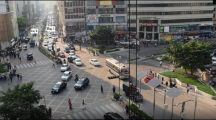Abstract
Increased vehicular population in second-tier urban areas and disobedience to the traffic laws by the road users (pedestrians and others) leads to a significant concern about the safety. This has become a very serious problem, unable to be controlled either by the enforcement or any means. In the present study, a city has been selected where the population is less than five lakhs but the substantial population of the vehicles and uncontrolled intersections are formed by adopting poor technical methods in town development. Eleven uncontrolled intersections were selected along the major arterial roads. The method adopted for data collection is a videography survey. The data collected were pedestrian volume, traffic volume, and the approaching speed of the vehicles. Also, the pedestrian characteristics were extracted to analyze the crossing behavior, gap acceptance, and critical gap. From the analysis, it is concluded that road geometry and traffic control device plays a significant role in pedestrian safety. In this analysis, while selecting the intersections, its formation, layout, and geometry are analyzed. Pedestrian crossing speed (15th percentile) was compared to the standard value 1.2 m/s and its relation between road geometry, pedestrian traffic control devices or signs, pedestrian characteristics, and traffic volume are analyzed. It is concluded that the 15th percentile speed of pedestrians did not meet the standard value 1.2 m/s in most of the intersections and male pedestrians crossing speed (1.39 m/s) is found to be higher when compared to crossing speed of female pedestrians (0.76 m/s). The critical gap is lesser for two-wheelers when compared to other classes of vehicles indicating that the size of the vehicles has a significant influence on gap acceptance, pedestrian crossing behavior, and critical gap.
Access this chapter
Tax calculation will be finalised at checkout
Purchases are for personal use only
Similar content being viewed by others
References
Ravishankar KVR, Nair PM (2018) Pedestrian risk analysis at uncontrolled mid-blocks and unsignalised intersections. J Traffic Transp Eng 5(2):137–147
Ramesh A, Ashritha K, Kumar M (2018) Development of model for pedestrian gap based on land use pattern at midblock location and estimation of delay at intersections. J Inst Eng (India): Ser A 99 (3), 413–422
Danaf M, Sabari A, Abou-Zeid M, Kyasi I (2018) Pedestrian–vehicular interactions in a mixed street environment. Int J Transp Res, 1–13
Raghuram Kadali B, Vedagiri P (2017) Evaluation of pedestrian accepted vehicle gaps with varied roadway width under mixed traffic conditions. Int J Transp Res, 1–10
Priyadarshini Priyanka, Mitra Sudeshna (2017) Investigating pedestrian risk factors leading to pedestrian fatalities in Kolkata city roads. Transp Develop Econ 18(6):287–301
Uttley Jim, Fotios Steve (2017) The effect of ambient light condition on road traffic collisions involving pedestrians on pedestrian crossings. Accid Anal Prev 108:189–200
Chandra S, Rastogi R, Das VR (2014) Descriptive and parametric analysis of pedestrian gap acceptance in mixed traffic conditions. KSCE J Civ Eng 18(1):284–293
Pollack KM, Gielen AC, Nasir M (2014) Investigating and improving pedestrian safety in an urban environment. Inj Epidemiol 1(11):189–200
Rastogi R, Chandra S, Vamsheedhar J, Das VR (2011) Parametric study of pedestrian speeds at midblock crossings. J Urban Plan Dev 137 (4), 381–189
Sahani R, Saipriya M, Bhuyan BK (2018) Application of gap acceptance concept to investigate crossing behavior of pedestrians at unsignalized intersections. Transp Dev Econ 4(15), 1–8
Laxman KK, Rastogi R, Chandra S (2010) Pedestrian flow characteristics in mixed traffic conditions. J Urban Plan Dev 136(1):23–33
Kadali RB, Perumal V (2016) Critical gap analysis based on pedestrian behaviour during peak hour traffic at unprotected midblock crosswalks. Asian Transp Stud 4(1):261–277
Boroujerdian AM, Nemati M (2016) Pedestrian gap acceptance logit model in unsignalized crosswalks conflict zone. Int J Transp Eng 4(2):87–96
Author information
Authors and Affiliations
Corresponding author
Editor information
Editors and Affiliations
Rights and permissions
Copyright information
© 2021 Springer Nature Singapore Pte Ltd.
About this paper
Cite this paper
Niveditha, S.P., Mallesha, K.M. (2021). Analysis of Pedestrian Crossing Behavior at Uncontrolled Intersections. In: Pathak, K.K., Bandara, J.M.S.J., Agrawal, R. (eds) Recent Trends in Civil Engineering. Lecture Notes in Civil Engineering, vol 77. Springer, Singapore. https://doi.org/10.1007/978-981-15-5195-6_32
Download citation
DOI: https://doi.org/10.1007/978-981-15-5195-6_32
Published:
Publisher Name: Springer, Singapore
Print ISBN: 978-981-15-5194-9
Online ISBN: 978-981-15-5195-6
eBook Packages: EngineeringEngineering (R0)




